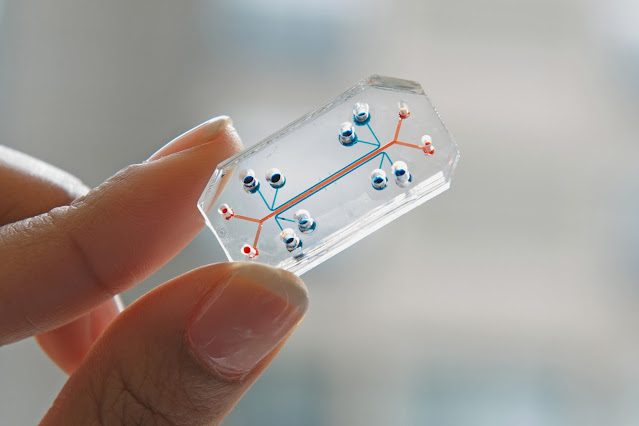 |
| Organ-on-a-chip |
A captivating scientific and technological advance known as an Organ-On-A-Chip (OoC) mimics important elements of human physiology by combining biology and microtechnology. The chip is designed as a microfluidic device with networks of hair-thin microchannels for directing and controlling minuscule quantities of solution. The small tissues developed and residing in the microfluidic chip are more appropriately referred to as the organ because they can reproduce any number of tissue-specific functionalities. Although these systems are far more basic than actual tissues and organs, researchers have shown that they may frequently act as accurate mimics of human physiology and illness.
Organ-on-a-chip includes cutting-edge in vitro technology that makes it possible to conduct experiments on biological cells and tissues outside of the body. This is accomplished by keeping them inside vessels designed to maintain an environment that, from a biochemical and physical standpoint, bears a passing resemblance to the in vivo environment. The ability to directly examine cell and tissue behavior and to have more power regarding the microenvironment that supports tissue life are two unique advantages of working at the microscale.
Microsystems technology, a catch-all term for fabrication techniques adapted from the integrated circuit industry, has been the second major factor in the success of OoC. In this method, objects in the nano- and micrometer range are produced via lithographic pattern transfer. Organ-on-a-chip development milestones are linked to significant advancements in microsystems technology. Microsystems technology has pushed towards the creation of both microfluidic and miniaturized actuator and sensor capabilities of OoCs. It was first employed in analytical chemistry to construct laboratory-on-a-chip devices. At the preclinical development stage, these single-organ chip assays can aid in identifying important biological mechanisms and test drug efficacy and toxicity in target organs, serving as an accurate guide for clinical trials. Any electronic device implanted subcutaneously (subdermally), typically through an injection, is referred to as a human microchip implant.
